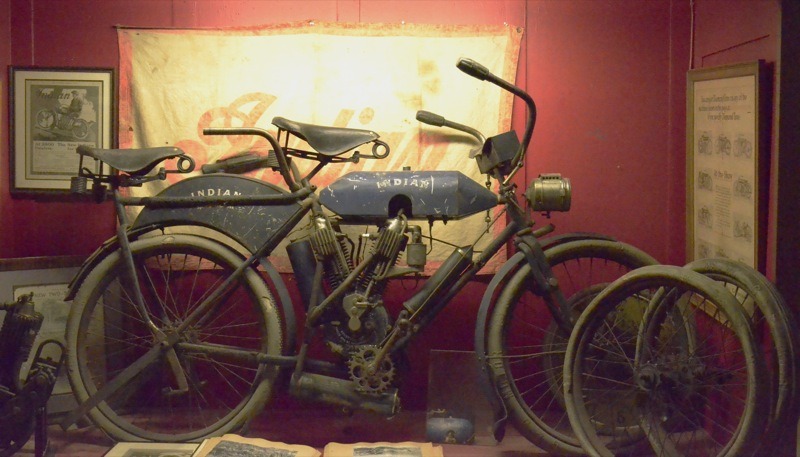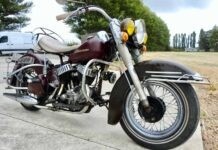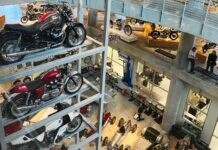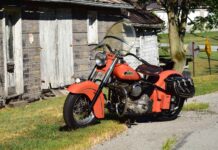MAGGIE VALLEY, N.C.,–The scruffy blue motorcycle stopped me in my tracks. The V-twin Indian was fitted with two gas tanks and a tandem seat. Standing in the Wheels Through Time Museum in Maggie Valley, North Carolina, the realization dawned that I was looking at a piece of nearly forgotten history.
The question as to what year the Hendee Manufacturing Company first offered a V-twin is put to rest by a company sales brochure dated June 1906. “In presenting the Indian for the season of 1906… ” clearly states that the two motorcycles offered to retail customers were ’06 models. One of these was the Indian Double Cylinder Racer rated at 4 hp, weight of 108 lbs. and priced at $350.

The new V-twin was patterned after the factory racer and didn’t have twist grips or fenders. The gas tank was a torpedo design that straddled the horizontal bar of the frame, and not the camelback gas tank on the regular model. Other details were pedals with toe clips (just like those on modern bicycles), shorter handlebars, and the crank chain didn’t have a metal guard. It was fitted with a special split saddle positioned behind the seat tube.
The 1906 sales brochure was titled: “Indian Motocycle / Which Renders Possible / the / Indian Tri-Car / Indian Tricycle / Indian Tandem / Indian Triplet / and the / Indian Van / Substantially Six Vehicles In One.” These six variations of the 1906 Indian were based on two attachments, a rear tandem seat and a chassis that replaced the front wheel of the motorcycle with a frame having two parallel, steerable front wheels.
The tandem attachment was an extended crossbar fitted with fixed handlebars, a Brooks saddle and a split brace that was bolted to the rear axle of the motorcycle. The tandem was offered as an accessory for $15—a bargain considering that the Brooks spring suspension saddle sold for $8.
The fore-frame attachment was more complex, and its most touted feature was the new independent helical suspension. “Each wheel of the tri-car proper being flexibly independent of the other, it is free to conform to any depression, elevation or other inequality of the road without regard to its mate, the finely tempered spring permitting each wheel to yield sufficiently to preserve the equilibrium or even balance of the whole machine.” For the sedan chair, the body was made of aluminum, upholstered in dark blue leather and suspended on springs in the frame. The front frame by itself created the Indian Tricycle; with an enclosed container mounted between the front wheels it became the Indian Van, and fitted with a sedan chair it was called the Indian Tri-Car.

The Tri-Car was extensively tested in 1905, including competing in the F.A.M. (Federation of American Motorcyclists) endurance contest. Carrying two passengers, the Indian Tri-Car completed the run from New York to Waltham, Massachusetts, in 16 hours and 20 minutes. In another competition held by the Brooklyn Motocycle Club, the Indian Triplet (Tri-Car with the tandem attachment) carried three passengers weighing a total of 430 pounds and completed the round-trip course from Brooklyn, New York, to Southampton, Long Island, New York, in less than 11 hours of riding time. All this on a motorcycle with a single-cylinder, 2 1/4 hp engine!
Some of the historical confusion regarding the year Hendee Manufacturing Company first introduced their V-twin results from the introduction of 1907 models in September of 1906. The standard camelback motorcycle with twist grips, Brooks saddle and long handlebars was called the “Indian Roadster” and it was offered with either the improved 2 3/4 hp single-cylinder or a 3 1/2 hp V-twin engine. According to the 1907 sales brochure, “This [Indian Twin-Cylinder Motocycle] model in practically all save the motor is a reproduction of the single-cylinder Indian. Its means of transmission and control and its equipment are identical with the latter. The twin cylinders are made of the same metals and are of the same dimensions as the other, but their doubling, of course, increases the capacity of the engine to 4 horsepower…” A couple of the first 1907 V-twin Roadsters to be manufactured were shipped to California in July, enabling George Holden and Louis Mueller to begin their record-breaking transcontinental trek from San Francisco to New York on August 10.
Hendee manufactured 1,698 motorcycles in 1906. Surviving records don’t indicate how many of these were V-twins. However, records for the 1907 models show that serial numbers T100-T499 were V-twins and that 2,176 motorcycles sold that year. Two-cylinder engines with serial numbers not prefaced by “T” apparently were manufactured in 1906, even though they were Roadster models. The Hedstrom (Indian) engines had been built under license by the Aurora Automatic Machinery Company in Illinois since 1901, but the new 2 3/4 hp single- and twin-cylinder engines were manufactured at the new Indian factory on State Street in Springfield, Massachusetts, in 1906. My investigations suggest that a new series of serial numbers began at this time.

For obvious reasons the higher-powered V-twin became preferred by those fitting the $125 Tri-Car or Van attachments to their motorcycles. Most surviving antique photographs show these arrangements with V-twin engines. By 1908 the Tri-Car was produced in limited quantities and the twin-cylinder engine had been improved to deliver 5 hp, while that for the race version—which still had a torpedo gas tank—now produced 7 hp. The dusty blue motorcycle in the Wheels Through Time Museum is a 1908 model, a 5 hp V-twin fitted with a tandem attachment and both a torpedo gas tank on the crossbar and a camel tank on the rear fender. I can only assume that this particular motorcycle was set up for a cross-country endurance contest, but the secret of its origins probably lies hidden in a long-forgotten newspaper story filed in the special archives of some local public library.
There can be little argument that the first U.S. production V-twin motorcycles were made by Glenn Curtis under the Hercules brand name, not by Hendee Manufacturing Company. On Memorial Day in 1903, Glenn Curtiss showed up at the New York Motorcycle Club’s first hill climb event with his new V-twin motorcycle. He not only won the hill climb, but later also set a land-speed record on this machine in Yonkers, New York. That same year, Thomas Baldwin ordered a Curtiss V-twin engine and installed it in a dirigible to make the first successful powered flight in 1904. Sold under the brand name Hercules, Curtiss was selling street versions—with an optional tandem seat—of his 5 hp V-twin by 1905 and the American Motorcycle Company (Marsh-Metz) was offering a 4 hp 1000cc V-twin in 1906.
Nor can American inventors claim to have invented the V-twin, since these motorcycles first appeared in Europe in 1902 with the Griffon. By 1906, 15 different European motorcycle brands offered V-twins. Indian was not the first manufacturer of V-twin engines and Harley-Davidson was a relative latecomer to the market, but these two iconic marques would be responsible for inextricably associating the V-twin engine with American motorcycles.


















